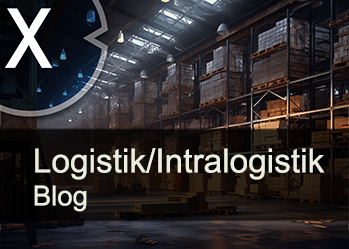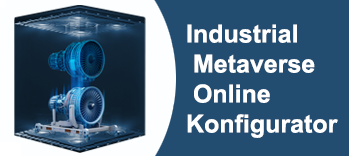Container high-bay warehouses and container terminals: The logistical interaction – expert advice and solutions
Xpert pre-release
Language selection 📢
Published on: August 1, 2025 / Updated on: August 1, 2025 – Author: Konrad Wolfenstein

Container high-bay warehouses and container terminals: The logistical interplay – Expert advice and solutions – Creative image: Xpert.Digital
Container high-bay warehouses: The future of global port logistics
How vertical storage is revolutionizing container terminals and container ports worldwide
Global container logistics faces enormous challenges. More than 90 percent of global trade in goods is handled by sea, and container sizes on ships are continually growing. At the same time, traditional container terminals are reaching their physical and operational limits. Limited port space, rising throughput volumes, and the need for ever more efficient handling have led to a revolutionary development: the high-bay container warehouse.
This innovative technology promises to fundamentally change container logistics. Instead of stacking containers horizontally as before, they are stored vertically in multi-tiered steel rack structures. This not only enables a drastic increase in storage capacity within the same space but also revolutionizes the entire processes in the container terminal.
Basics of container high-bay warehouse technology
Technical structure and functionality
A container high-bay warehouse is a fully automated storage system specifically designed for handling standard sea containers. Its basic architecture differs radically from conventional container yards. While traditional terminals stack containers flat on the ground, high-bay warehouses utilize a vertical storage philosophy in massive steel rack structures.
The heart of the system are the stacker cranes, also known as storage and retrieval machines. These rail-guided cranes move in the narrow aisles between the rows of racks and can precisely load and retrieve containers at heights of up to eleven levels. Each container is assigned an individual storage location, allowing the rack structure to bear the entire weight, eliminating the need for containers to rest on top of each other.
Storage and retrieval are fully automated. When a container arrives at the terminal, it is identified at special transfer stations and picked up by the stacker cranes. The system automatically calculates the optimal storage location, taking into account various factors such as weight, destination port, scheduled departure time, and current capacity utilization. During retrieval, each container can be accessed directly without restacking other units.
Software architecture and control systems
The performance of a high-bay container warehouse depends crucially on its software architecture. Three interconnected system levels control the complex processes: the Terminal Operating System (TOS), the Warehouse Management System (WMS), and the Warehouse Control System (WCS).
The Terminal Operating System acts as the overarching planning platform for the entire terminal. It communicates with external partners such as shipping companies, freight forwarders, and rail transport companies, manages ship calls and truck time slots, and coordinates all container movements across the terminal grounds. The TOS specifies the strategic framework, for example, which containers arrive when and by what time they must be ready for specific ships.
The warehouse management system handles the tactical level of warehouse control. It manages every single container in the system, optimizes storage locations, and plans movements so that frequently used containers are placed in favorable positions. The WMS also performs forward-looking relocations, in which containers are moved to better positions before their actual pickup.
The Warehouse Control System represents the operational level and controls the physical movements of the stacker cranes in real time. It translates the WMS planning specifications into concrete machine commands and continuously monitors the system status. These three software levels work seamlessly together, enabling complete automation of warehouse processes.
Increased efficiency and operational benefits
Revolutionizing the handling speed
Container high-bay warehouses achieve dramatic improvements in turnaround times. The most important metric is truck turnaround time, which in conventional terminals is often 30 to 90 minutes or more. These waiting times are primarily caused by the search for the desired container and the laborious restacking of overlying units.
A high-bay warehouse can reduce these times to under 20 minutes. This is due to direct access to each container without restacking. When a truck arrives at the terminal, the requested container is already in the optimal position thanks to software-controlled pre-planning or can be retrieved by the stacker cranes within a few minutes. This speed is accompanied by unprecedented planning reliability, as the system can offer guaranteed retrieval times.
Ship handling also benefits significantly from high-bay warehouse technology. Containers can be prepared in the exact loading sequence, reducing ship layover times. Since no time is lost searching for or restacking containers, valuable berth space can be used more efficiently.
Space efficiency and capacity increase
The most important advantage of high-bay container warehouses is their enormous space efficiency. While traditional container yards can typically only stack four to six containers high, high-bay warehouses allow for up to eleven storage levels. This vertical compression triples the storage capacity on the same floor space.
This space saving is particularly valuable in expensive port areas, where land is often scarce and expensive. Instead of developing new terminal areas or expanding existing ones horizontally, ports can significantly increase their capacity by building high-bay warehouses on existing sites. This is not only economically advantageous but also more ecologically sustainable, as no new areas need to be sealed.
The increased capacity also has a positive impact on the terminal's flexibility. Larger buffer capacities make it easier to absorb fluctuations in shipping traffic and remain operational even in the event of unforeseen events. This is particularly important given the trend toward increasingly larger container ships, which can unload and load several thousand containers during a single port call.
Integration into the terminal ecosystem
Interfaces to existing systems
Container high-bay warehouses are not isolated systems, but must be seamlessly integrated into the existing terminal infrastructure. The transfer points between the high-bay warehouse and the other terminal areas are critical.
On the waterside, the connection is made via automated transport systems. Driverless transport vehicles or rail-mounted gantry cranes transport the containers between the container bridges on the quay and the transfer stations of the high-bay warehouse. These systems are also fully automated and can efficiently handle large container volumes.
On the land side, special truck docking stations will be set up where the containers will be placed directly onto the truck chassis. These stations are designed to enable fast and safe transfers. Parallel connections to rail terminals will be provided, where containers can be loaded onto rail wagons.
The integration of different transport systems requires precise coordination. The Terminal Operating System must coordinate all movements to avoid congestion or waiting times. Modern terminals use simulation software and artificial intelligence to optimize complex material flows.
Automation and human-machine cooperation
Although high-bay container warehouses are highly automated, humans still play an important role. However, automation is leading to a change in job profiles. Instead of physical labor, monitoring, control, and maintenance tasks are becoming increasingly important.
Modern terminals rely on an intelligent division of labor between humans and machines. Humans make complex decisions that require flexibility, while machines perform repetitive and labor-intensive tasks. This not only leads to greater efficiency but also to better working conditions and greater safety.
The remote control of container cranes is one example of this development. Instead of sitting in crane cabs at dizzying heights, crane operators can control the container cranes from comfortable control stations on the ground. This improves both workplace quality and efficiency, as one crane operator can operate multiple cranes.
Sustainability and environmental benefits
Energy efficiency and emission reduction
Container high-bay warehouses offer significant advantages for the environmental impact of container terminals. The electric storage and retrieval machines are significantly more energy-efficient than the diesel-powered straddle carriers used in conventional terminals. Because they run on rails and utilize regenerative braking systems, they consume less energy per container moved.
The compact design of high-bay warehouses also reduces energy consumption for lighting and air conditioning. Because the rack aisles are narrow and the storage space is concentrated, fewer areas need to be lit and heated. Modern systems also utilize LED lighting with motion detectors to further minimize energy consumption.
Another sustainability benefit is the reduction of noise and light emissions. High-bay warehouses are typically enclosed or covered facilities, which means the noise level for the surrounding area is significantly lower than that of open container yards. This is especially important in urban port areas, where terminals are often located near residential areas.
Long-term resource conservation
The increased space efficiency of high-bay container warehouses contributes to resource conservation. Since less floor space is required, fewer natural habitats need to be used for port expansions. This is particularly relevant in coastal areas, where port expansions often encroach on ecologically sensitive areas such as mudflats or marshlands.
The steel structures of the high-bay warehouses are also durable and can be recycled at the end of their useful life. Compared to the frequent renovations and expansions of conventional container yards, they offer a more sustainable infrastructure. The automated systems also have a longer service life than conventional container handling equipment because they operate more precisely and experience less wear.
Advice – planning – implementation
I would be happy to serve as your personal advisor.
Head of Business Development
Port challenge: New technologies for efficient container storage
Challenges and implementation
Technical and economic hurdles
The implementation of high-bay container warehouses involves significant capital expenditure. Initial costs are significantly higher than those of conventional container yards, as complex steel structures and sophisticated automation technology are required. These high capital costs must be recouped through operational savings and increased handling capacity.
The technical complexity of the systems also requires specialized expertise in planning, construction, and operation. Terminal operators must train their employees accordingly and establish new maintenance and service structures. This poses particular challenges for smaller port operators.
Another critical issue is system integration. Container high-bay warehouses must be seamlessly integrated with existing terminal processes. This often requires extensive adaptations to IT systems and operational processes. In existing terminals, structural constraints can also complicate implementation.
Adaptation to local conditions
Not every port is equally suitable for high-bay container warehouses. Geological conditions must be sufficiently strong to support the tall steel structures. In areas with soft soils or high seismic risk, additional foundation measures may be necessary.
Climatic conditions also play a role. In regions with extreme weather conditions, systems must be designed to be robust. Wind, ice, and corrosion from salt water can compromise operational reliability and require special protective measures.
Integration into existing port structures presents another challenge. Many ports have grown over decades and have complex infrastructures with diverse interfaces. The transition to high-bay warehouse technology often requires a fundamental reorganization of terminal processes.
Digital networking and future technologies
Networking with global supply chains
Container high-bay warehouses are not just local optimizations, but part of a more comprehensive digitalization of global supply chains. Complete transparency over every container in the system enables all supply chain participants to plan precisely.
Shippers and freight forwarders receive real-time information on the status of their containers and can synchronize their downstream logistics processes accordingly. This enables just-in-time deliveries and reduces the need for buffer stocks in the supply chain. This significantly increases planning reliability and makes supply chains more efficient overall.
Data collection in high-bay warehouses also provides valuable insights for supply chain optimization. By analyzing container movements, dwell times, and transport patterns, logistics service providers can improve their services and identify bottlenecks early on.
Artificial intelligence and predictive systems
Modern high-bay container warehouses are increasingly using artificial intelligence and machine learning to optimize their processes. These systems can learn from historical data and make predictions about future container flows. This allows containers to be preemptively moved into optimal positions before they are actually needed.
Predictive maintenance concepts utilize sensor data from storage and retrieval machines to detect wear and tear and potential failures early on. This reduces unplanned downtime and increases system availability. Continuous monitoring of system parameters also enables optimization of energy consumption and operating costs.
The integration of 5G technology opens up further possibilities for real-time system control. Low latency and high data rates allow even complex control tasks to be transmitted wirelessly. This increases system flexibility and enables new application scenarios.
International developments and market trends
Pioneer locations and reference projects
The first high-bay container warehouses are already in operation or under construction. The most prominent example is the BOXBAY system at Jebel Ali Port in Dubai, which has been successfully handling containers for several years. After more than 63,000 container handling operations in trial runs, the technology and operational processes have proven their worth.
Further projects are planned or under construction in various regions of the world. The Port of Busan in South Korea will receive a BOXBAY system that is expected to reduce truck handling times by 20 percent. Concrete plans for high-bay container warehouses are also underway in Europe, with the Port of Hamburg considered one of the pioneers.
These reference projects are important for the further dissemination of the technology. They demonstrate practical feasibility and provide operational experience that can be used to optimize future facilities. Successful implementations also reduce the perceived risk for other port operators.
Technological advancements
Container high-bay warehouse technology is continually evolving. New generations of storage and retrieval machines are becoming lighter, faster, and more energy-efficient. The integration of robotic technologies enables more flexible handling systems that can also handle damaged or atypical containers.
The software systems are also constantly being improved. New algorithms for storage space optimization and route planning for storage and retrieval machines are further increasing efficiency. The integration of blockchain technologies could also improve the security and traceability of container flows in the future.
Modular designs allow high-bay warehouses to be expanded gradually and adapted to changing requirements. This reduces investment risks and makes the technology attractive even for smaller ports. Standardized interfaces facilitate the integration of various system components and reduce dependence on individual suppliers.
Economic impacts and business models
Transformation of the port industry
High-bay container warehouses are fundamentally changing business models in the port industry. Instead of simply offering space and handling capacity, ports can market high-quality logistics services with guaranteed service levels. The predictability and reliability of high-bay warehouses make it possible to offer premium services that command correspondingly higher prices.
Increased efficiency also leads to changes in cost structures. While capital costs rise, operating costs decrease through automation and optimized processes. In the long term, high-bay container warehouses can therefore be more cost-effective than conventional systems, despite higher initial investments.
The technology also enables new cooperation models between ports, shipping companies, and logistics service providers. Improved planning capabilities enable long-term capacity contracts to be concluded, providing greater security for all parties involved. This can lead to more stable revenues and better financing options.
Impact on employment
Automation through high-bay container warehouses has complex implications for employment in ports. On the one hand, traditional jobs such as crane operators and straddle carrier drivers are being eliminated or reduced. On the other hand, new, higher-skilled jobs are being created in system monitoring, maintenance, and IT support.
The transformation requires extensive training measures for the existing workforce. Many port operators are therefore investing heavily in continuing education programs to prepare their employees for the new requirements. This is also important for society to maintain acceptance of the technological changes.
In the long term, the more efficient processes can lead to growth in the port industry, which in turn creates new jobs. The increased competitiveness of automated ports can gain market share and thereby increase overall volume. This shows that technological progress does not necessarily lead to job losses.
Outlook and future prospects
Expansion into the hinterland
Container high-bay storage technology is expected to spread beyond seaports. Inland terminals at major rail hubs and freight centers could also benefit from the technology. These "dry ports" would serve as buffer storage between long-haul transport and regional distribution.
By shifting storage capacity to the hinterland, congested port regions can be relieved. Containers could be transported inland immediately upon arrival and temporarily stored in high-bay warehouses. This would reduce traffic pressure in port cities while simultaneously increasing the flexibility of supply chains.
Connecting different high-bay warehouse locations could lead to an integrated logistics network. Containers could be automatically rerouted between different warehouses to avoid bottlenecks or optimize transport routes. This would further increase the efficiency of the entire logistics system.
Integration with other future technologies
The future of container high-bay warehouses lies in integration with other innovative technologies. Autonomous transport vehicles could take over the connection between different terminal areas and operate more flexibly than currently available systems. Drones could be used for inspections and maintenance work.
Blockchain technologies could further improve the transparency and security of container flows. Each container could be assigned a digital identity containing all relevant information about its contents, origin, and destination. This would speed up customs clearance and reduce the risk of counterfeiting or smuggling.
The integration of Internet of Things sensors into containers and storage systems would enable even more precise monitoring. Temperature, humidity, vibration, and other parameters could be continuously measured and used to optimize storage. This would be particularly important for sensitive goods such as pharmaceuticals or food.
Container high-bay warehouse technology is still in its early stages of development, but has already demonstrated the potential to revolutionize container logistics. The combination of vertical storage, complete automation, and intelligent software creates a completely new paradigm for container terminals. While implementation is complex and capital-intensive, the long-term benefits promise a sustainable transformation of global port logistics. The successful integration of container high-bay warehouses into the terminal ecosystem will be crucial to how container logistics evolves in the coming decades.
Advice – planning – implementation
I would be happy to serve as your personal advisor.
Head of Business Development
Advice – planning – implementation
I would be happy to serve as your personal advisor.
contact me under Wolfenstein ∂ Xpert.digital
call me under +49 89 674 804 (Munich)
























